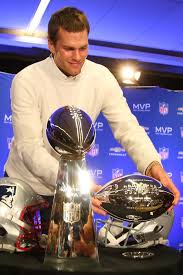🏈 “Not Even 7 Rings Could Silence the Doubt: The Untold Battle That Drove Tom Brady”
He won more Super Bowls than any player in NFL history. He rewrote the quarterback record books. He became the face of greatness. But behind the six-round pick turned legend was a man battling something far more persistent than any linebacker: doubt. Long after the world crowned him the GOAT, Tom Brady still carried the scars of being told he wasn’t good enough — and that relentless voice never stopped chasing him.

Tom Brady’s story is often told as a fairytale: from the 199th overall pick in the 2000 NFL Draft to the greatest quarterback to ever step on a football field. But what’s often overlooked is the deeper, more human part of his journey — the emotional and mental cost of chasing perfection for over two decades.
Brady wasn’t born into NFL stardom. He was doubted at every level: benched in high school, overlooked at Michigan, passed over by nearly every NFL team. When he finally got his chance in New England, it wasn’t talent alone that fueled him — it was fear. The fear of going back to being forgotten.
In countless interviews, even after winning his third, fourth, and fifth rings, Brady admitted something most champions don’t say out loud: he still didn’t feel satisfied. “There’s always someone out there working to take your spot,” he once said. “You stop, you lose.”

The world saw the highlights — the 28-3 comeback, the clutch throws, the records. But few saw the 3 a.m. workouts, the meals eaten alone, the endless tape study. Fewer still saw what it cost him behind closed doors.
As his career climbed to legendary status, the pressure mounted. After two decades in New England, Brady left the Patriots in 2020 and took a massive gamble with Tampa Bay. At 43 years old, many assumed he would finally fade. Instead, he won his seventh Super Bowl. But that triumph came with another kind of toll: the growing strain between football and family.
By 2022, rumors of his marital issues with supermodel Gisele Bündchen were no longer rumors. That fall, the couple confirmed their divorce. Brady’s decision to unretire and continue playing another year reportedly added fuel to an already complicated relationship — and for the first time in his career, fans saw the cracks behind the champion’s armor.
Brady’s final season in the NFL wasn’t about stats or wins. It was about finishing on his terms. But even in his retirement video, there was a sense of vulnerability: a man tired, not just physically, but emotionally. “You only get one super emotional retirement essay,” he said, choking up. “And I used mine last year.”
His decision to walk away — this time for good — was met with widespread praise, but also quiet reflection. For all the rings and accolades, Brady had paid a heavy price: years of his life consumed by a game that had once been his escape from insecurity, but had gradually become his identity.
In truth, Tom Brady’s greatest battle wasn’t against Peyton Manning or Aaron Donald — it was against himself. Against the internal voice that said he wasn’t enough. Against the fear that if he stopped, the world might forget where he started.

Now, post-football, Brady is entering a new chapter. He’s a part-owner of the Las Vegas Raiders. He’s preparing for a broadcasting career. He’s spending more time with his children. But for a man who spent 23 years trying to outrun doubt, the transition from gladiator to civilian may be the hardest test yet.
The legend of Tom Brady is set in stone. But the man behind the myth? That story is still unfolding — and it’s one that deserves to be told.





























